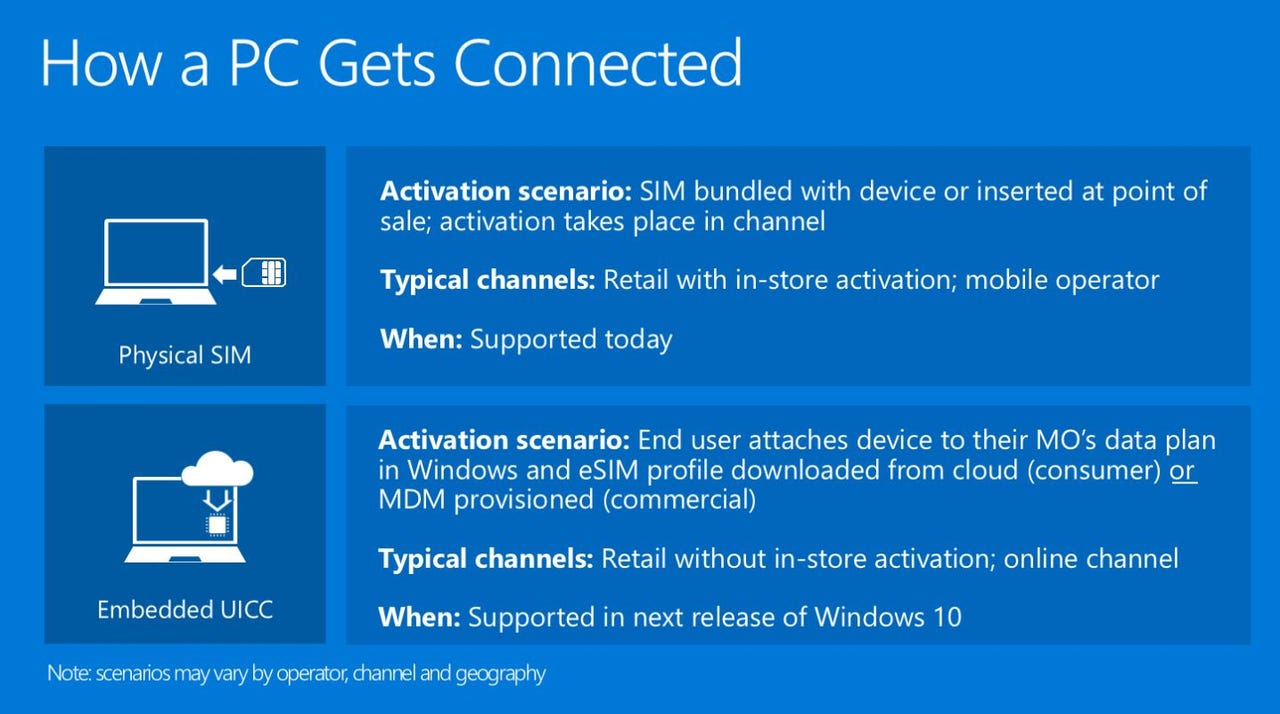Windows 10 to get new cellular connectivity, power-management improvements

Microsoft and its "Always Connected" partners are working to beef up cellular connectivity and power management features likely to end up in the Windows 10 "Redstone 4" release due in the Spring of 2018.
Microsoft officials shared some tidbits about these new features during the WinHEC Fall 2017 Workshop, which ran November 2017 to December 1 in Taipei. Some of the slides from presentations during that event are on Microsoft's Channel 9. (Thanks to @h0x0d, The Walking Cat, for the heads up.)

One WinHEC session focused on Always Connected PCs -- the Intel/ARM-based thin and light devices that include eSIM technology so they're always on and connected to cellular networks. Microsoft and partners showed off a couple of the coming Qualcomm ARM-based Always Connected devices at the Snapdragon Tech Summit earlier this week.
Currently, some Windows 10 PCs -- including Surface Pros -- include the ability to connect to LTE networks using a SIM bundled with the device or inserted at a point of sale. But with Redstone 4, Microsoft is working to make cellular connectivity more seamless, according to the recent WinHEC presentation.
End users will be able to attach their devices to their mobile operators' data plan in Windows and eSIM profiles will be able to be downloaded from the cloud. No in-store activation will be required for this "Consumer eSIM" capability. This feature will be supported "in the next release of Windows 10," though usage will depend on operators, channels and geographic regions.
As part of Redstone 4, Microsoft also will be piloting an Enterprise eSIM feature. Via this feature, enterprises will be able to bulk-purchase cellular subscriptions from mobile operators and use mobile device management services like Microsoft's Intune, to provision the connectivity automatically.
Microsoft officials said earlier this week that they believe Always Connected PCs could be an enterprise play at some point due to the increased security/lower costs of using LTE inside corporations vs. wifi networks.
Properly working lower power capabilities are key to extending battery life in Windows 10 devices. So it's not surprising Microsoft also is continuing to try (and try again) to improve the power management capabilities in each version of Windows 10.
Currently, Windows 10 offers "Modern Standby," an evolution of Connected Standby. In WinHEC slides from a presentation about Modern Standby, Microsoft describes it as "an 'umbrella' term for Connected Standby and Disconnected Standby." Modern Standby is what manages background activities and certain wake scenarios not available on legacy power modes.
Microsoft and Intel are going to hold PlugFests that they're hoping will drive "accelerated readiness" of Modern Standby devices. The two plan to certify devices that pass tests. They are also working together to get Modern Standy enabled on desktops and not just mobile devices, according to the WinHEC slides. Wake-on Remote Desktop, a complement to Wake-on Voice and Wake-on Fingerprint reader, will be a new scenario enabled by this.
Microsoft and Qualcomm had been hoping to see the first PC makers start shipping Windows 10 on ARM "Always Connected" devices before the end of calendar 2017. We learned this week that the first such devices won't launch until early 2018. Given Redstone 4 is due to begin shipping to mainstream users around April 2018, maybe these first Qualcomm 835 devices, along with new Intel-based Always Connected PCs, could incorporate some of these new cellular and power-management improvements.